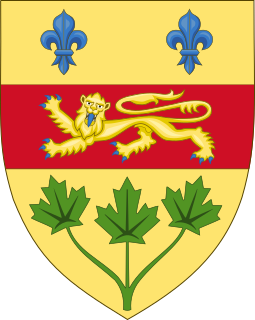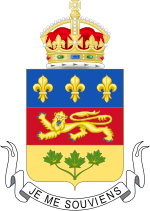
The Quebec Liberal Party is a federalist provincial political party in Quebec, Canada. It has been independent of the federal Liberal Party of Canada since 1955.

The Quebec sovereignty movement is a political movement as well as an ideology of values, concepts and ideas that advocates independence for the Canadian province of Quebec.
The politics of Quebec are centred on a provincial government resembling that of the other Canadian provinces, namely a constitutional monarchy and parliamentary democracy. The capital of Quebec is Quebec City, where the Lieutenant Governor, Premier, the legislature, and cabinet reside.

Honoré Mercier was a lawyer, journalist and politician in Quebec, Canada. He was the ninth Premier of Quebec from January 27, 1887 to December 21, 1891, as leader of the Parti National or Quebec Liberal Party (PLQ). He rose to power by mobilizing the Francophone opposition to the execution of Louis Riel, denouncing it as a betrayal by John A. Macdonald's Conservative government.

The National Assembly of Quebec is the legislative body of the province of Quebec in Canada. Legislators are called MNAs. The Queen in Right of Quebec, represented by the Lieutenant Governor of Quebec and the National Assembly compose the Legislature of Quebec, which operates in a fashion similar to those of other Westminster-style parliamentary systems.

Quebec has played a special role in French history; the modern province occupies much of the land where French settlers founded the colony of Canada in the 17th and 18th centuries. The population is predominantly French-speaking and Roman Catholic, with a large Anglophone minority, augmented in recent years by immigrants from Asia. The political alienation of the Francophones from the Anglophones has been a persistent theme since the late 19th century. Tensions were especially high during the First World War. Historically, British merchants and financiers controlled the economy and dominated Montreal. The Catholic Church, in close cooperation with the landowners, led a highly traditional social structure in rural and small town Quebec. Much of that changed during the Quiet Revolution of the 1960s. Quebec's separatists, calling for an independent nation, gained strength but were narrowly defeated in two referenda. Quebec imposed increasingly stringent laws favouring the French language; many Anglophones left, as did many of the national and international corporations that had been based in Montreal.

This section of the Timeline of Quebec history concerns the events relating to the province of Quebec, Canada between the Westminster statute and the "Quiet Revolution."

This section of the Timeline of Quebec history concerns the events relating to the province of Quebec, Canada between the beginning of the 20th century and the Westminster statute.
The Constitutional debate of Canada is an ongoing debate covering various political issues regarding the fundamental law of the country. The debate can be traced back to the Royal Proclamation, issued on October 7, 1763, following the signing of the Treaty of Paris (1763) wherein France ceded most of New France to Great Britain in favour of keeping Guadeloupe.
The 1886 Quebec general election on October 14, 1886 to elect members of the 6th Legislative Assembly for the Province of Quebec, Canada. The Parti National, a broad coalition formed and led by Honoré Mercier, that included the Parti libéral du Québec and nationalist defectors from the Conservative party. The Parti national got a large boost when Liberals and dissident Conservatives rallied in reaction to the hanging of Louis Riel in 1885, for which the federal Conservatives were held responsible by Quebec voters. The nationalists won a majority of seats against the Parti conservateur du Québec, led by John Jones Ross.

The 1867 Quebec general election was held in August and September 1867 to elect members of the First Legislature for the Province of Quebec, Canada. The Quebec Conservative Party, led by Premier Pierre-Joseph-Olivier Chauveau, defeated the Quebec Liberal Party led by Henri-Gustave Joly de Lotbinière.

Peter Mitchell, was a Canadian politician and one of the Fathers of Confederation.
Canadian federal elections have provided the following results in Eastern Montreal.
The Conservative Party of Quebec was a political party in Quebec, Canada, from 1867 until 1936, when it merged with members of the Action libérale nationale to form the Union Nationale.
Gaspard Fauteux, was a Canadian parliamentarian, Speaker of the House of Commons of Canada (1945–1949), and the 19th Lieutenant Governor of Quebec (1950–1958).
Arthur Turcotte was a Quebec lawyer, journalist and political figure.
The 6th Legislative Assembly of Quebec was the provincial legislature in Quebec, Canada that existed from October 14, 1886, to June 17, 1890. During most of the term, the Quebec Liberal Party, also known as the Parti national as that period, was the governing party. However, the Quebec Conservative Party despite losing the election tried to form a minority government with John Jones Ross and Louis-Olivier Taillon as Premiers but only managed to last a few months before the Liberals led by Honoré Mercier, the founder of the Parti National, formed a narrow majority government with 33 of the 65 seats of the Legislative Assembly of Quebec.

The Fourth Legislature of Quebec was the provincial legislature of Quebec, Canada that existed from 1878 to 1881, following the general election of 1878.
The Parti National was the name taken by the Liberal Party of Quebec, Canada, under the premiership of Honoré Mercier.
















